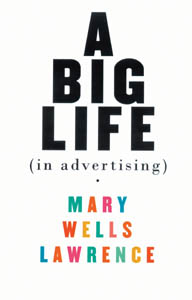A BIG LIFE
A BIG LIFE (in advertising)

Everything old is new again
At Procter & Gamble it wasn’t a man who was the leader, it was a philosophy, and that was so powerful it transformed the people who worked there, turning a lot of individuals into one mind and one voice.
In 1968, when we went to work for P&G, it set the standard in the package-goods world for controlled, scientific marketing-religious consumer research, self discipline, relentless will and staying power. The mystique of Procter & Gamble was so dynamic that each executive was viewed as an atomic part of a huge omniscient power by the outside world. Procter’s executives, once they had trained there, were in such demand they could move to almost any other company and increase their fortunes.
Advertising agencies who worked for Procter were viewed as sophisticates who could be counted on to work scientifically and maturely. However, like the Catholic Church, the company kept a pragmatic eye out for small miracles beyond their control and invested, warmly but warily, in one or two of the most intuitive, spontaneous agencies.
It was the press touting our success with troubled brands that caught their eye. One of Procter’s laws was that a product had too much invested in it to be allowed to die and if it was given the right branding idea and the right advertising it never would. So an exorbitant amount of time and expense was invested to bring back the dead and to give rebirth to brands that began to droop. Procter’s Crest toothpaste with fluoride to fight cavities had received the ADA claim and was winning the sweepstakes. Procter’s other toothpaste, Gleem, had once enjoyed a 45 percent share of the toothpaste market. After Crest appeared with fluoride, Gleem steadily lost share of market and was becoming an emergency. Ed Harness, who was soon to become chairman, liked the idea of trying a hot creative agency for Gleem. Ed Lotspeich, the corporate advertising manager, was sent to take a look at Wells Rich Greene to see how far-out we might be. He looked us over with a dry eye, but we passed his test and were duly invited to Cincinnati to meet the toothpaste executives at the Queens City Club, where for years agencies were hired and fired, encouraged or warned, while breakfast or lunch was served by sweet little ladies in crisp green uniforms with lace caps. I had no idea of what we were taking on when we went to work for Procter & Gamble-it was so different from any account I had ever wrapped myself around, it was so structured and so sure of its infallibility. It would take me and most of Wells Rich Greene years to enjoy their ways, and Procter would worry and shake its head about us until we did.
We hired Al Wolfe to manage the account because he had strong package-goods experience and when I met him I thought he was smart and sensitive enough to loosen up and swing with us. He had a hard time. He did learn to appreciate the flamboyant creativity but I think he despaired of us getting into Procter’s formulaic groove. “The Blonde,” he called me: “The Blonde” think this, ” The Blonde” said that. I imagine this cheeky expression gave him some distance from the emotions he felt working for a woman-in person, he was unfailingly polite to me. I couldn’t have cared less what monikers Al or anyone else at the agency found therapeutic, I was aware of the difficulties some of the men had working for me. There were no other women creating agencies as I was with large, big-time, big-budget accounts. Women-in-business was just becoming a big issue. A few talented men resigned from the agency because they found the idea of working for a woman intolerable. Herb Fisher, whom I admired and had big plans for, confronted me in the middle of a busy hallway on a difficult day when I was wishing I had been born with ten heads. “Mary, I’ve made up my mind about something and the sooner I tell you the better. I can’t do this. I can’t work for a woman. I don’t think you can handle all this. I have to run this agency-or I have to leave.” And so, of course, he left.
Marty Stern, our marketing director, was ecstatic when we got the Gleem account. Dick Rich was not. He liked to feel like a star with clients and Procter’s controlling science made him crazy. When his first campaign for Gleem was not received well at P&G, he reacted with a New York shrug and disinterest and I found myself in Charlie Moss’s office with yet another opportunity for him and Stan.
Charlie was working 25-hour days at the time but he and Stan began staying even later, had burgers and fries sent up every midnight, and finally came up with a taste strategy for Gleem that I liked a lot. Crest, the competition, had fluoride, a real ingredient in an era when toothpastes contained ghost ingredients that worked more on your mind than on your teeth. Fortunately, from Wells Rich Greene’s point of view, fluoride toothpaste did not taste good at first and a lot of kids didn’t want to brush their teeth with it. Charlie and Stan’s idea was to exaggerate the delicious taste of Gleem, a toothpaste without fluoride, in television commercials where mothers chased their sons and daughters up and down and around the house, caught them, made them brush their teeth with Gleem, whereupon the kids discovered they loved the taste of Gleem and brushed their teeth happily ever after. The point was that it is better to have your kids brushing their teeth with a toothpaste they like than to have them refuse to brush their teeth at all with a fluoride toothpaste. Charlie’s “Best Tasting Toothpaste in the World” campaign was a hit at Procter and it was a hit with television viewers, too-even by Procter’s standards the commercials got extremely high recall scores-and it was a hit with mothers and kids. We firmly held our own against Crest.
A few years, however, Procter decided that they should put fluoride into Gleem. There went the good-taste strategy that was saving Gleem’s business! Gleem began to taste like any other fluoride toothpaste, and we were back to square one. By that time Procter had assigned us Safeguard soap, Prell shampoo, Sure deodorant and a long line of other products and we found ourselves having a love affair with a client who cherished us for challenging them with big ideas and arresting advertising but who constantly reproached us, in an ideological struggle filled with long sermons, for not really getting their act.
We agreed with the basic underpinnings of Procter’s creed but they had created a painfully slow, Byzantine organization with layers of management that had to be convinced not only that advertising was on-strategy but that each nuance was Procter correct. Procter believed that these different levels of control kept intuition and creativity on the right track. Unfortunately, the executives at different levels had different levels of experience and ability. The agency was expected to escort its creativity at the top, using all the persuasion it could muster. It was also expected to help train Procter’s young executives along the way, those who, in their early years, were inexperienced so, naturally, were opinionated.
When the agency finally reached the powerful guys on the top floors-the Bob Whelings, Bob Goldsteins, Steve Donovans, Sandy Weiners, Bill Connells, John Smales, John Peppers, Tom Lacos and Bob Blanchards-Procter & Gamble marketing became individual and courageous and tried to resurrect any magic lost along the way. These names may not mean as much to you as Sting, Mick, Bono or Bowie, but that only means you don’t know the package-goods business. They are package-goods stars. And good guys, the kind you want for blood buddies or husbands and fathers of your children.
I spent a lot of time with those good guys and I wondered why I never met a wife. So I organized a lunch for wives only and I invited Mrs. Ed Harness, who was then the wife of the chairman. It seemed a perfectly natural thing to do as a female head of one of their agencies, although no one had done such a thing before, so my lunch was viewed nervously in Cincinnati. We were a little itchy together at first but we all quickly dropped our hair, the way women do, and had a great time. I made friends I cherish, like Nancy Donovan, a bright light of a businesswoman. But best of all was what I learned in the long discussions the group of us had, taking us late into the dinner hour-candid information I would never have learned any other way-women are so communicative. I have never revealed one precious word from that charming lunch and I certainly won’t now
The most tedious P&G meetings were inside Wells Rich Greene-boring struggles when our Procter & Gamble account representatives tried to control our feisty creatives. Al Wolfe felt trapped between P&G’s system and what he saw as Charlie Moss’s arrogant dismissal of an expression Charlie loathes. They were the less talented people who bought the agency time for the superachievers to get around to producing the right stuff. They were enablers, and everyone who has ever run an agency has enablers to fill up time until a superior talent is free. No matter how hard we searched, no matter how much money we paid-and we paid extraordinary salaries-we were never uniformly talented. No agency is. There isn’t enough talent in the business. The knowing use of enablers, who are not talented enough but are sweetly willing, is one of the darker sides of creative business.
Looking back, as though from the window of a rocket, I see Procter & Gamble as a space station in its own galaxy, a world all its own, filled with converts who had been screened for uninhibited, exhibitionist, mercurial traits or anything that might pollute the environment. Life in the space station was civilized-sensible, rational, smart enough to be interesting and full of good guys who generally agreed with one another. Life was in control. If you had a problem, you could take it to the high priests of research-their reports were viewed as safe and sure guides to success.
What I did for love
The way I’m telling it you’d think each account was a distinct experience and that we focused on each of them one at a time. But that’s not how it was. They all happened at the same time in an explosion. Jack Landry and Ron Chapin rode up to our offices in the same elevator on the same day and when they got out on our floor, Charlie Tillinghast, Gordon Sherman and Peter Godfrey got in and went down.
Here is the rhythm of the gentle chaos in a typical 48-hour period of my advertising days, which could be technically demanding, terribly dull and inconsequential; the world didn’t always tilt. Still-48 advertising hours could be amazing, with arialike moments and without farce.
I got off the plane from Detroit after that first press conference we had at American Motors and dashed to Grand Central Station, where we were hanging a spectacular, three-dimensional ad for Boodles gin over the main waiting room. A gin martini was the only drink I ever learned to like other than wine and I felt strongly about what gin should be, so when we got the Boodles business I did a test run comparing it to the gins I knew and loved and discovered that Boodles was better. Drier. Harding put it on all Braniff flights and I talked it up all over town. I explained to Charlie, who didn’t know gin, that Boodles was great because it made a martini without flowers-you know, that slightly floral aftertaste you can get with gin. Charlie blew that visual picture up into a vast red mouth with flowers coming out of it and gave it the words ” Martinis Without Flowers” and hung it high at Grand Central Station. I wanted to see it before heading back to the office, where I was due to see ideas for new snacks I was going to present the next morning to General Mills in Minneapolis. When I walked into Grand Central I was pleased to see there were crowds standing under the big red mouth with flowers, everybody seemed to be nodding their heads in understanding. So I rushed on to the agency.
The snack people were getting impatient and rambunctious outside my office and Kathie was giving me her infuriated look, but Jack Landry had come up from Phillip Morris and was waiting to see me. “Come on, Little Tiger, come have a drink with me. We have to talk.” Jack and I liked each other, trusted each other, we had become each other’s security blankets in the political wear and tear at Phillip Morris. I thought his marketing abilities at Phillip Morris were extraordinary. He never got enough credit for that company’s success. He was a late-day drinker, though, and I always tried to meet with him in the morning. The Leo Burnett Marlboro men handled their late-day bat meetings with Jack with gusto and style, but I couldn’t do that (a distinct advantage in being a woman).
I followed him out of the office that evening because I knew what he wanted to talk about. Benson & Hedges sales had soared to record heights on the strength of our television commercials. But the TV ban on cigarette advertising had forced us to take our campaign off television and into print, and Dick didn’t have the same gift for print he had for television. Herb Green and George D’Amato, who had come with us when we left Jack Tinker, had tried to adapt the campaign into print but a lot was lost in the translation. At the bar, downstairs, Jack said he had to level with me, he didn’t believe the Benson & Hedges television campaign was ever going to make it in print. “It’s a television idea, Mary,” he said, “you can’t make a silk purse out of it.” What to do? We talked for an hour or so, I tried to change his mind and he was sympathetic, but I left with palpitations, promising to get back to him within the week. It was getting dark, I had a few thousand other things to do besides save the Benson & Hedges account, I had to sample and select snacks to take to Minneapolis, name them (Monkeys, Rabbits and Squirrels, maybe?) and write the speech I was due to give shortly. (I was forever giving speeches. When clients asked me to give them I couldn’t say no and as I was the advertising flavor of the day, I was invited to speak to advertising and sales executive clubs all over America. We were trying to build awareness of the agency in all areas of the country so it also seemed smart to accept invitations to speak to Rotary groups and newspaper associations and bank conferences, even a meatpackers’ convention. I spent one entire flight home to Dallas studying America’s meatpackers’ problems, but I came down on the side of the cows and that just added to my worries. The problem was that I couldn’t give speeches that were written for me myself to bring out Mary Wells the Actress, so I was always writing them in snatches on napkins, notepads, Kleenex, anything available anywhere.)
When I got to the agency I saw Stan Dragoti about to leave for the night and I was struck by a monumental hunch. I grabbed him and told him about Jack’s fears about Benson & Hedges and said I thought that he, Stan, was the one who could reassure Jack that we could keep the brand growing in print. “I don’t even know Jack. Why am I the magic messenger? How could I know what to say to convince him?” Stan protested. I insisted that Jack would appreciate his great, prize-winning reputation in print, and anyway, I just knew he was Jack’s kind of guy, he could give Jack a little more faith and buy us the time we needed. Shaking his head, Stan hurried over to the bar, introduced himself to Jack, and found a way to reassure him that if he gave us time we would find the answer to the Benson & Hedges print campaign. I don’t know where that hunch came from, the agency business is so fast moving and so full of emergencies, you learn when to jump without looking and when to fly without wings.
The next morning, while I was in Minneapolis presenting snack ideas to General Mills, Bob Adler, who ran the Bic business, called the agency and gave us their felt-tip pen to advertise. We named it the Bic Banana and Mel Brooks became the voice-over for the commercials. “Some tree!” Mel said, walking by our grand spiraling wood stairway in the entrance hall on his way to meet Bob Adler.
Bob Adler was a master at promoting disposable, impulse pens and lighters and razors. His idea was to put all his money behind one Bic product, sensationalize it, and it would then sell all the other products. He chose the right agency. ” Flick your Bic” was Charlie’s line. He had to force it down the throats of his creative team, Adam Hanft and Maurice Mahler, but once they gave in and accepted it, they were otherworldly wonderful. Their commercials put Gillette’s Cricket lighter, the established one, out of business for a time. Lew Wechsler, our head of TV programming, flooded Hollywood with the lighters and we got about 100 prime-time jokes from stars like Bob Hope using the line “Flick your Bic.” We thought of it as free advertising.
It gets a lot worse than cold in Minneapolis. When I got up the morning of my snack meetings it was so far below zero the radio reported people were freezing to death on their way from their homes to their cars. My motel room was not connected under cover to the lobby and I faced a life-threatening walk to the taxi that would take me to General Mills. I called the agency to see if anyone had found a way to solve Jack Benson’s & Hedges print problem, but no one had. No one had by the time I reached Wells Rich Greene, either, that afternoon. Charlie and Stan were meeting with a group from American Motors, so I looked around the buzzing agency and I couldn’t find anybody who was rethinking the Benson & Hedges print. I would have had a tantrum, but I knew Charlie. So instead, at about seven p.m. I went out and sat very quietly in the chair outside my office and stopped breathing. In a few minutes Charlie and Stan came shuffling down the hall on their way home. They had to pass me and by that time I was grey from not breathing. They stopped to say goodnight, looked at me, took a few more steps. Then Charlie said, “We can’t go.” Stan: “Why? What’s wrong?” Charlie: “She’ll get sick. She’s so depressed about Benson & Hedges. She’s all alone, she won’t go home, she’ll stay all night like that. We can’t go. We’ve gotta find an answer.” They returned to their offices. I went into mine, ordered up pizzas and wrote my speech. About midnight they were back and they had a line, “America’s favorite cigarette break,” and ideas for breaking cigarettes that finally made the television work in print and we all went home.
Waiting for Charlie and Stan, I had telephoned Dorothy Carter, the smart doctor who was a consultant at Miles Laboratories. I’d thought of her on the plane from Minneapolis because I’d seen an Alka-Seltzer commercial the night before at the motel. It was very funny commercial about spicy meatballs that was getting raves in the agency world and would win many awards. But I knew that Walter Compton would be unhappy with it. He didn’t want humor to be so extreme it was all you remembered about an Alka-Seltzer commercial. Then Dorothy Carter jumped into my mind. She was happy to hear from me. She said that Alka-Seltzer sales had been off, Walter Compton had left Tinker and gone to Doyle Dane Bernbach looking for another sales turn around, but he wasn’t happy, he was always telling her that I was the only one who understood Alka-Seltzer the way he did. “Perhaps,” she said, “you and I should meet and have a talk about Alka-Seltzer’s future?” I made a date. I was pleased with myself; I went to bed and dreamt of hurdles.
Life has its hallucinatory moments, or certainly mine has, but in the sixties and early seventies you had to work a little harder to stay focused, so many large questions had been let loose-protest, authority, war, death, civil rights, women’s rights, freedom, individuality. They weren’t new questions but they were being presented so regularly on television you couldn’t look away as you might have before. Awareness is at the very core of the advertising business, you have to be aware of what is happening today, now, this minute, to be connected, to be effective, not only about the issues but also about style, trends, art. So in my head Alka-Seltzer, long cigarettes and making Midas a household word were bumping up against Vietnam, the Kennedy assassinations, Martin Luther King and Neil Armstrong padding around in moon dust-not to mention Andy Warhol, Alice Cooper and what had become of Abbie Hoffman. And I had added the quagmire of taking Wells Rich Greene public.
We took the stock over the counter on Halloween, 1968, not long after we’d gotten the TWA account and in the glow of the publicity we’d received for the American Motors campaign and the success of Benson & Hedges. We believed that stock options would give us a gold stick to throw out in front of talents we would want to hire as well as help us hang on to the valuable talent we already had. We innocently thought that the leverage in options would make Wells Rich Greene tighten up expenses and exercise restraints. We thought our people would mature. Well, that never happened. Paul Hallingby of White Weld & Co. had been suggested to me as an investment banker by Harding’s banker, Gus Levy, at Goldman Sachs and he led us through the offering. Our IPO had a business plan behind it but no real track record, just like the IPOs of the nineties. The stock opened at $17 a share. Dick and Stew and I each sold shares worth a little more than $1,200,000. Then we sailed into stockholders’ meetings, board of directors’ meetings and meetings with investment bankers in all the big cities.
I invited Harding’s lawyer, Arnold Grant, to be a member of Wells Rich Greene’s board. He said, “You know, Leland Hayward is a client of mine and I bet he’d get a kick out of being on an advertising agency board. He’d certainly get the gist of it. Why don’t you take him to lunch and talk to him about it?” So I took Leland to the Colony Club and proposed to him and he was tickled pink to become a board member. Troy Post, still the head of GreatAmerica, and Emilio Pucci were also happy to join the board. It was a merry group; the outside directors were fond of us and very helpful. The disciplines and long-term planning and financial reporting that accompanied public ownership and the time that took out of my overpromised life might have sunk me but for their help and, more important, Harding’s. Harding was always a beam of clear vision to help me machete my way through the jungles in each year’s financial plans and results.
To make the stock easier to buy, we planned to move it from over the counter to the American Stock Exchange; Paul Hallingby had completed the plans and wanted to meet the next morning. We met so early that the cleaning lady hadn’t reached my office yet and that pizza Charlie and Stan and I’d had the night before was still hanging around. Paul wrinkled his nose and left as soon as he could. I was speaking at the New York Sales Executive lunch that day and needed to shine my speech. Bill Claggett, a major executive at Ralston Purina, would be sitting next to me and I wanted to impress him and persuade him to give us some of his dog-foos business. Also on my Do It Immediately list was my speech for the coming TWA road show, the presentation I had to make in Detroit to sell American Motors on a nervy idea we had for the next campaign, the speech I would need in a couple of weeks when I would be inducted into the Copywriters Hall of Fame, a speech to the American Marketing Association in Atlanta-part of the deal I’d made with Bill Durkee when he gave us the RC Cola and Diet Rite business- and an emergency trip to California I had to make, preferably yesterday, to untangle a knot in our relationship with Al Crossin, a smart, highly expectant executive at Hunt-Wesson.
Add the potential disasters that hovered like spooks in our dark corners, for example: the fact that I did not like, in fact I did not even understand, the work we had done so far on RC Cola and I had promised Bill Durkee that our campaign would put RC Cola right up there with Coke and Pepsi. Add my belief that the group handling Love Cosmetics was falling apart. Love had grown into an extended line of products that required us to advertise more heavily in print ads. They were being written by a choir of ladies, an odd group, some of them older, Revlon Fire & Ice types and some of them kohl-eyed, go-go Mary Quant types, one of whom put a hex on Charlie and his children when we fired her, making Charlie unbearable for a couple of weeks. It was not easy to find great fashion advertising writers. But Peter Godfrey was becoming as uneasy about the ladies as I was, so somewhere in the world we had to find replacements soon or that account would fall into the arms of another agency that was wooing Peter Godfrey, just waiting for us to fail.
Add to that the surprises-like the call I got from Don Swanson and Bruce Atwater saying they had decided to hurry up the launch of the new snacks I’d presented to them in Minneapolis so we needed advertising for them immediately, how soon could I return to Minneapolis? And, finally, add the unexpected blows like Charlie and Stan’s announcement, mid-pizza, that they had to have a vacation or die. They’d rented a house in St. Tropez for three weeks, where they were going to go come hell or high water to write a movie. In the late sixties and the seventies everybody on Madison Avenue wanted to make movies and few were actually making them.
These days there are smart ways to deal with stress. In those days and many years I dealt with it by dancing. When I got to my apartment nights I turned on Sly Stone and “I Want to Take You Higher” and I hoofed, I strutted and pranced and boogied and stomped and shimmied and sometimes I slipped in a hula or a tango. Later I shook my booty with the Sunshine Band. I shook until I could get out of my head and into the tub. Then I would sit in the water, a zombie. People in the building averted their eyes when we shared an elevator. God knows what they thought. The best song I ever found for shaking my psyche into shape was “I Will Survive.” It’s still better than any pill.
Harding and I made a pact we would talk to each other every night no matter how late before we went to sleep. I called the kids earlier, when they got home from school, but Harding and I talked late into every night, wherever he was in the world, calming each other, loving each other, promising each other anything.
By 1971 I knew these things: that there were few people who could build a hot advertising agency, and I would not be able to hire one of them to help me build mine because he would be building one of his own-and that in the real world there was no one who would be a better creative director for Wells Rich Greene than Charlie Moss-and that if I lost Charlie Moss to the movie business I was stupid.
From the book A BIG LIFE (IN ADVERTISING) by Mary Wells Lawrence. Copyright (c) 2002 by Mary L. Book Corp.
Reprinted with the permission of Alfred A. Knopf, a division of Random House, Inc. Mary Wells Lawrence, Alfred A. Knopf, a division of Random House, Inc.
Copyright © 2002 by Mary L. Book Corp. All rights reserved.






